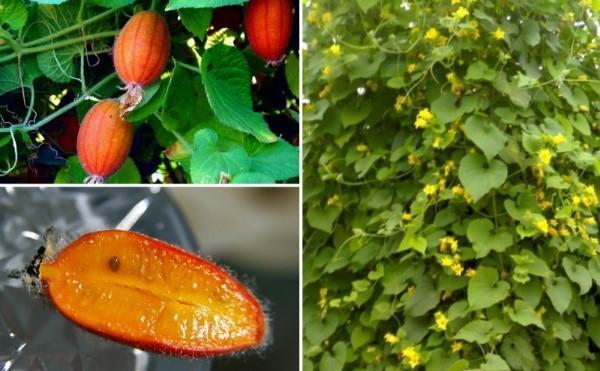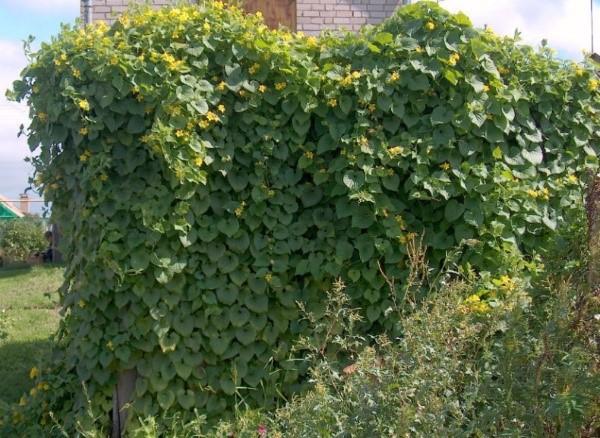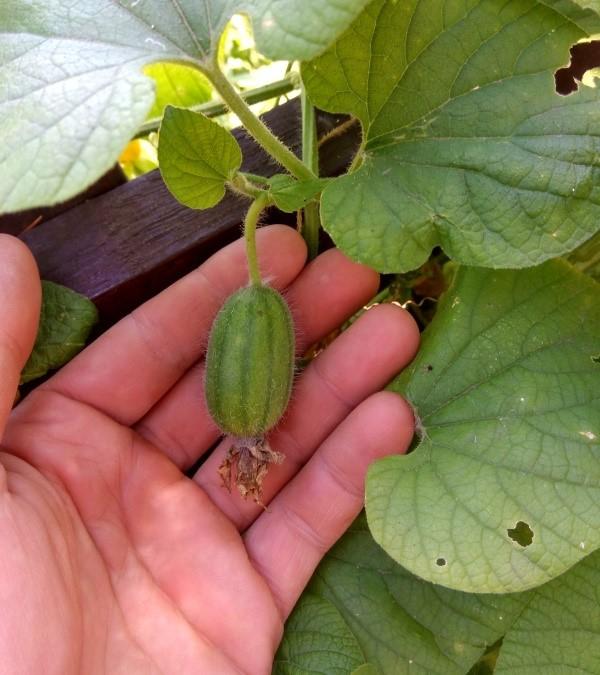Tladianta: red cucumber - we grow a sweet exotic vegetable at home
 It's no secret that vegetables can taste anything, but they certainly aren't sugary. However, there is one exception to the rule - this is tladianta (red cucumber). Although it is exotic, it is still a vegetable, with a delicious sweet pulp. The fruits of the tladiant really look like cucumbers, but only red in color and inside with seeds, like watermelon... But with its long lashes, the bush looks more like a pumpkin, of which it is a relative. Moreover, if you dig it up, you can harvest tubers, like potatoes - this is the root system, it is inedible. Here is such an interesting plant. What vegetable does the tladiant have most in common: potatoes, pumpkin or cucumber? Today we will tell you who this plant really is and how to plant it in your garden.
It's no secret that vegetables can taste anything, but they certainly aren't sugary. However, there is one exception to the rule - this is tladianta (red cucumber). Although it is exotic, it is still a vegetable, with a delicious sweet pulp. The fruits of the tladiant really look like cucumbers, but only red in color and inside with seeds, like watermelon... But with its long lashes, the bush looks more like a pumpkin, of which it is a relative. Moreover, if you dig it up, you can harvest tubers, like potatoes - this is the root system, it is inedible. Here is such an interesting plant. What vegetable does the tladiant have most in common: potatoes, pumpkin or cucumber? Today we will tell you who this plant really is and how to plant it in your garden.
Description of the plant

Tladianta is a perennial plant and belongs to the pumpkin family. She has a lot in common with him. First of all, these are climbing stems, which grow up to 6 m in length during the season. Liana weaves well along the support. Basically, it is grown this way: on arches, near old trees or buildings that need to be covered. The only thing is that its pubescent shoots are more durable than those of a pumpkin. Liana leaves are more like squash leaves. They are the same round, on a thick stalk, but smaller. And the tladiana blooms all summer with beautiful, rich yellow bell-shaped flowers, like all pumpkin. But that's where the similarities end.
Features of fruiting tladiants
 As a perennial, the vine has a pronounced rest period. For the winter, its lashes completely die off, and only the root system in the form of tubers remains to winter in the soil. They are like our potatoes. But the fruits that ripen by mid-autumn are more like small red cucumbers. Because of this, the tladiant is known as the "red cucumber". The length of the cucumbers does not exceed 6 cm with a diameter of only 2 cm. At first they are green and shaggy, and after full maturation they turn red and the fluff disappears.
As a perennial, the vine has a pronounced rest period. For the winter, its lashes completely die off, and only the root system in the form of tubers remains to winter in the soil. They are like our potatoes. But the fruits that ripen by mid-autumn are more like small red cucumbers. Because of this, the tladiant is known as the "red cucumber". The length of the cucumbers does not exceed 6 cm with a diameter of only 2 cm. At first they are green and shaggy, and after full maturation they turn red and the fluff disappears.
 Unlike the hard and crunchy cucumber, the flesh of the tladiante is juicy and slightly reminiscent of cotton wool in structure. It is sweet, but the taste cannot be described in one word. It's a cross between kiwi, mango and pineapple. Interestingly, the seeds are almost the same as those of a watermelon: oblong, hard, black.
Unlike the hard and crunchy cucumber, the flesh of the tladiante is juicy and slightly reminiscent of cotton wool in structure. It is sweet, but the taste cannot be described in one word. It's a cross between kiwi, mango and pineapple. Interestingly, the seeds are almost the same as those of a watermelon: oblong, hard, black.
The fruits of the tladiant are edible. Green cucumbers can be pickled and rolled, and ripe ones make beautiful and tasty red jam.
The subtleties of growing tladiants
 Perennial "cucumber" vine can rightfully be considered one of the most unpretentious crops. Not only does she feel good both in the sun and in partial shade. Tladiant is also extremely tenacious and has a high self-propagation ability. Almost all the seeds that have fallen to the ground germinate, and every year it forms more and more nodule babies. Thus, in just a couple of years, the liana significantly expands its ownership, spreading over the site.
Perennial "cucumber" vine can rightfully be considered one of the most unpretentious crops. Not only does she feel good both in the sun and in partial shade. Tladiant is also extremely tenacious and has a high self-propagation ability. Almost all the seeds that have fallen to the ground germinate, and every year it forms more and more nodule babies. Thus, in just a couple of years, the liana significantly expands its ownership, spreading over the site.
Choosing a landing site
 As already mentioned, liana can grow in both sunny and shaded areas.The length of the lashes does not depend on this, but the flowering itself in the sun will be more abundant. It would be correct to plant the tladian near some kind of support, given its ability to drag. It doesn't have to be an arch. Due to the pubescence of the stems and foliage, the liana "settles down" well on the walls of buildings, gazebos, fences and trees. Gardeners often use this, practicing its cultivation as an ornamental cucumber. Tladianta quickly braids any support, creating a beautiful green wall and hiding everything you need underneath.
As already mentioned, liana can grow in both sunny and shaded areas.The length of the lashes does not depend on this, but the flowering itself in the sun will be more abundant. It would be correct to plant the tladian near some kind of support, given its ability to drag. It doesn't have to be an arch. Due to the pubescence of the stems and foliage, the liana "settles down" well on the walls of buildings, gazebos, fences and trees. Gardeners often use this, practicing its cultivation as an ornamental cucumber. Tladianta quickly braids any support, creating a beautiful green wall and hiding everything you need underneath.
When choosing a place, you must remember about the aggressive nature of the vine. It is advisable to plant it where there are no cultivated plants, so that the tladianta does not drown them.
This could be the back corner of the garden or along the fence. And so that the vine “does not go for a walk” throughout the site, it is better to limit its place of residence by digging in the slate at least 50 cm deep.
How to plant
 In our climate, tladianta most often reproduces with the help of tubers, and less often with seeds. This is due to the fact that it is extremely difficult to get seeds at home without effort. Both male and female flowers bloom on the bush at the same time. For fruit to set, the decorative cucumber must be pollinated. If you help and carry out pollination artificially, then the vine will delight you with a harvest and a large supply of seed. In the homeland of the plant, this work is done by "Asian" bees - small, living only in those parts. For some unknown reason, other insects do not like beautiful yellow gramophones. However, some gardeners who grow it claim that our black bumblebees sometimes cope with pollination.
In our climate, tladianta most often reproduces with the help of tubers, and less often with seeds. This is due to the fact that it is extremely difficult to get seeds at home without effort. Both male and female flowers bloom on the bush at the same time. For fruit to set, the decorative cucumber must be pollinated. If you help and carry out pollination artificially, then the vine will delight you with a harvest and a large supply of seed. In the homeland of the plant, this work is done by "Asian" bees - small, living only in those parts. For some unknown reason, other insects do not like beautiful yellow gramophones. However, some gardeners who grow it claim that our black bumblebees sometimes cope with pollination.
Tladianta is an ideal plant for breeding work.
Dusting the flowers with pollen from another culture from the pumpkin family, you can get an interesting result. The fruits change their shape, color and taste, but are usually always pitted. Therefore, in order to obtain seeds, it is necessary to pollinate an ornamental cucumber using only your own flowers.
For group planting, leave enough space between the bushes of red cucumber. Liana grows well not only upward, but also branches on the sides. In addition, the root system is actively growing new tubers. Next spring they can germinate even at a distance of up to 2 m from the mother bush.
When to plant
The timing of planting creepers depends on the method, namely:
- It is better to sow seeds first for seedlings, in the month of March. Since their shell is hard, they need to be stratified for 3 months. Before sowing, the seeds must be soaked for 6 hours. It is better to plant it immediately in separate cups - this is convenient, because the seeds are large enough. In open ground, seedlings of tladiants can be transplanted no earlier than May.
- Young nodules can be planted in the spring, when the soil warms up and frosts pass. Depending on the region, this can be late April - early May.
Tladianta: red cucumber - how to care for a vine
 Perennial vine is not a capricious plant. Although in fact it is exotic, but in our climate it is not bad at all. Tladiante winters are not terrible, because the entire above-ground part of the bush still dies off every year. The soil hides the tubers from snow and frost, and in the spring the vine revives again, letting out new shoots.
Perennial vine is not a capricious plant. Although in fact it is exotic, but in our climate it is not bad at all. Tladiante winters are not terrible, because the entire above-ground part of the bush still dies off every year. The soil hides the tubers from snow and frost, and in the spring the vine revives again, letting out new shoots.
Caring for a red cucumber is minimal and consists of the following activities:
- In order for flowering to be lush and the harvest to be plentiful, in hot summer, do not forget about the liana. Watering is necessary at least 2 times a week. If the soil under the bush is completely dry, the stems will become lethargic, and the ovary may fall off.
- Before laying the buds, you can feed the plant with ash and superphosphate. This will increase their number and make the bloom more lush.
- For fruit, sweet red cucumbers, it is imperative to pollinate the flowers. To do this, you need to walk with a brush first on the male, and then on the female inflorescences. You can simply pick off the male buds and touch the female buds with them.
- At the end of autumn, after harvesting, the aerial part of the bush should be completely cut off.
- In adult specimens, it is advisable to dig up some of the young tubers, also in autumn. Otherwise, the vine will be thick and spread over the site.
As you can see, the exotic liana is not very different in avoiding the usual garden crops. Plant a red cucumber for a Tladiant without even thinking. She will decorate your gazebo with yellow bell inflorescences all summer. And with the onset of autumn, it will give you original sweet cucumbers, from which you will make jam for the winter. And believe me: no one will have such a treat!